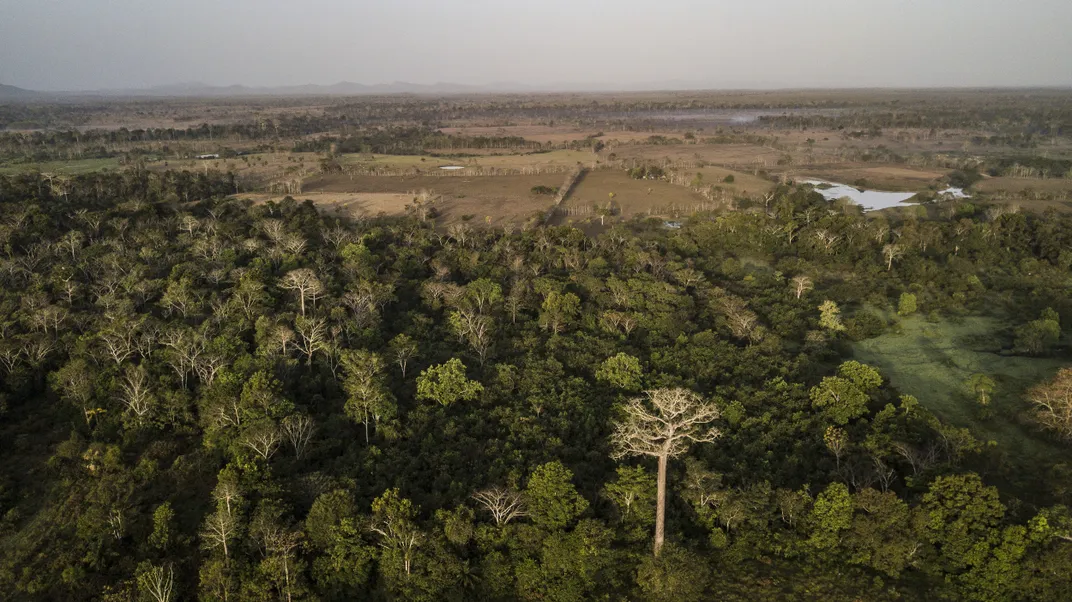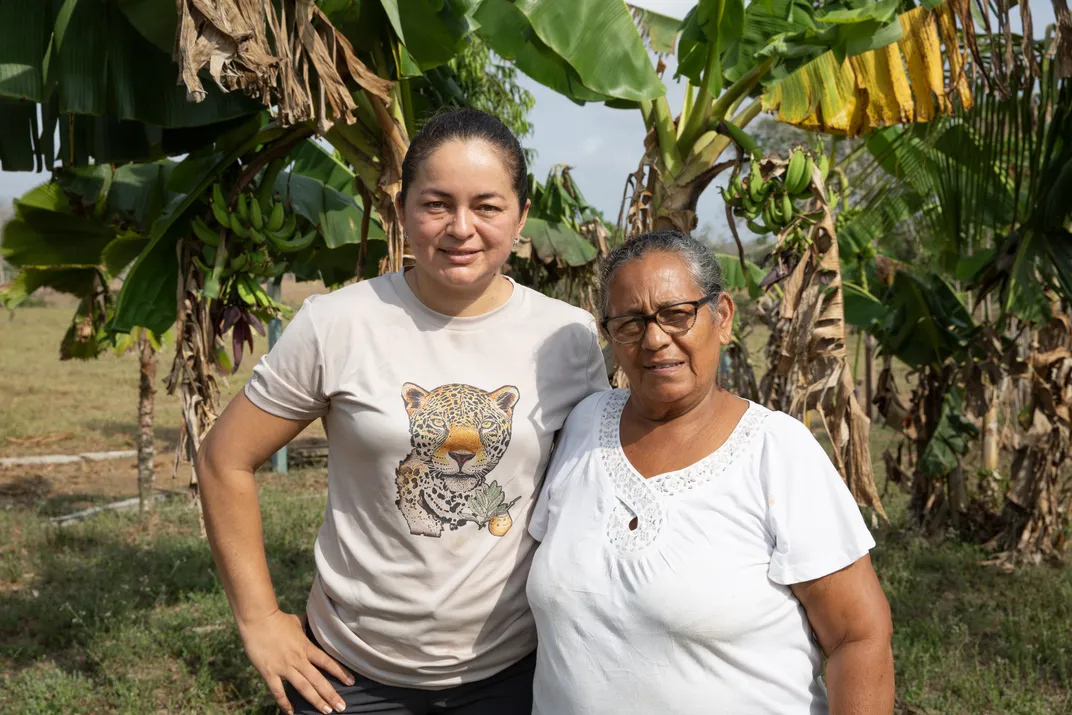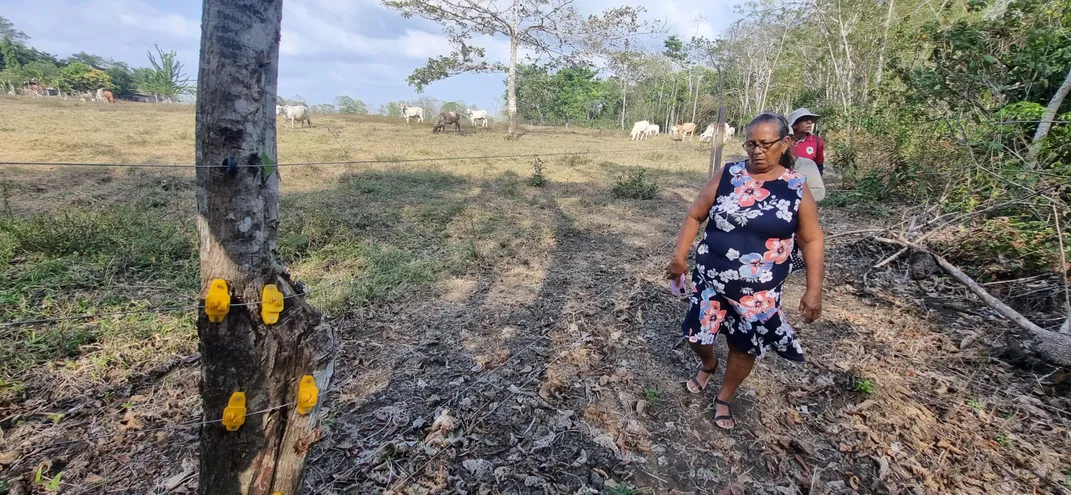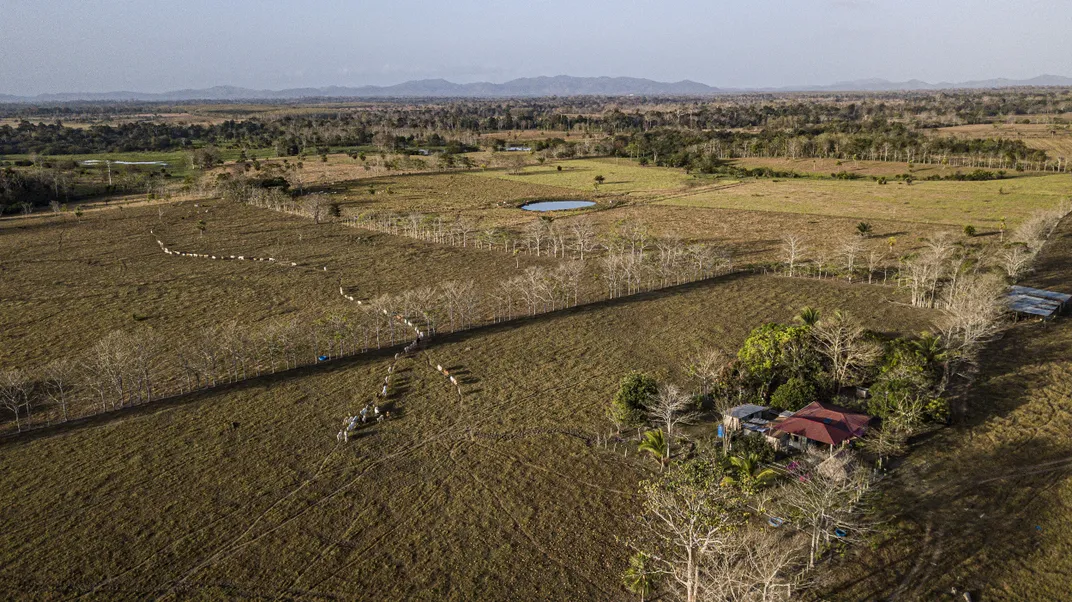SMITHSONIAN TROPICAL RESEARCH INSTITUTE
Between Pasture and Forest: The Crusade to Protect the Jaguar in Panama
Fundación Yaguará Panamá not only leads the protection of the largest feline in the Americas in cattle ranching areas of the country, but also promotes gender equality by actively involving women in key roles in the project, both at the scientific and community levels.
:focal(1963x1402:1964x1403)/https://tf-cmsv2-smithsonianmag-media.s3.amazonaws.com/filer_public/2e/62/2e620440-e0b0-4532-83dc-deeee23e6a91/imama_foto_antonio_de_la_torre_-_yaguara_panama.jpg)
“Is she coming with her baby? She can bring her baby. We can accommodate,” says Natalia Young, vice president of Fundación Yaguará Panamá, when we asked if there was a refrigerator at the camp where the photographer of this story could store breast milk. We had already heard about the commitment to gender equality promoted by the jaguar conservation project, but the response pleasantly surprised us. It was Fundación Yaguará Panamá’s last jaguar capture weekend for 2024 in Panama's Darien province, and we wanted to document it in person. The colleague accompanying me on the 36-hour expedition had a nursing baby.
For safety reasons, we did not take the baby. The drive from Panama City to the Yaguará Panamá camp in Agua Buena de Chucunaque in Darien would take almost five hours and part of the road was in poor condition. We would leave at four in the morning, visit the project during the day, sleep that night in a small hotel in the town of Metetí and return to the city in the morning.
Yaguará Panamá's efforts to conserve jaguars include various projects, such as an annual summer capture project. This initiative receives funding from Panama’s National Secretariat of Science, Technology and Innovation (SENACYT) and the Global Environment Facility (GEF) through the Global Wildlife Program (GWP). It is led by Ricardo Moreno, president of Fundación Yaguará Panamá and a research associate at the Smithsonian Tropical Research Institute (STRI), in partnership with Panama’s Ministry of Environment and with support from the United Nations Environment Program (UNEP).

The Yaguará Panamá team has detected more females with cubs in these areas of pastureland mixed with forest than in the Pirre highlands, a forested region within the Darien National Park that has been monitored with camera traps for a decade. So why do jaguars persist in environments that are supposedly not good for them?
“The answer may lie in the abundance of wild and domestic prey in this area,” Moreno explains. “It is easier for a female jaguar with cubs to prey on a calf that is going to drink water in the river and cannot defend itself, than to chase a herd of wild pigs with greater energy expenditure and where she can get wounded, and even risk death. These livestock depredations cause conflicts between ranchers and jaguars and generally end with the death of the jaguar at the hands of the ranchers in revenge for the loss of their cows”.
For Yaguará Panamá, the solution lies in getting to the root of the conflict. And that root is the lack of management or mismanagement of cattle ranches. This is crucial because the jaguar is already endangered in Panama according to national regulation (Resolution N° DM-0657-2016), and “near threatened”, according to the International Union for Conservation of Nature, due to habitat loss, poaching, illegal trade and conflicts with cattle ranchers.
We parked our pick-up truck in front of a pasture, a few kilometers from the De León family's Los Lagos farm, where the project's camp is located. Guillermo McPherson, Yaguará Panamá's wildlife biologist, pointed out the site where, a few days earlier, a jaguar had preyed on a 600-pound steer. Rather than killing the jaguar, because of the economic loss, the owner of the cattle alerted Yaguará Panamá so that they could make a report on the incident. This action demonstrates that the Fundación’s educational and awareness efforts are slowly bearing fruit.
“We set two camera traps, one focused on the dead steer and the other on a path where the jaguar could get to it,” says McPherson.
The jaguar normally returns to the site where it hunted its prey and continues to eat for several days. Through the images captured by the camera traps and by observing the spots on the jaguar's skin —which are unique, like a human fingerprint— the individual can be identified.
With the information gathered about the incident, Yaguará Panamá's technical team provided recommendations to the cattle owner for enhancing animal management. One suggestion included keeping the cattle closer to home, as it had to venture deep into the forest patch to access the river, where jaguars are known to roam. They also put her in contact with neighboring farms with which the Fundación is working on the implementation of sustainable management plans with anti-predation measures, for knowledge transfer.
Yaguará Panamá began working in Agua Buena de Chucunaque in 2017 and captured the first jaguar in 2019, a female they named Chucunaque. This initiative of capturing jaguars for satellite tracking with GPS collars picked up steam in 2022, after the pandemic, with the GEF-7 Jaguars Panama Project. Now, every summer, a team of wildlife biologists and veterinarians set up traps at various points in the forest patches where jaguars move. Then, for two months, they camp out at the Los Lagos farm, monitoring the trap transmitters every two hours to see if any of the traps have been triggered. The captured jaguars are fitted with GPS collars to monitor their movement and behavior for almost two years.
In line with Yaguará Panamá's commitment to gender equity, this year there are two female wildlife veterinarians in the capture project —Susana Ilescas from Mexico and Valentina Elis from Argentina— as well as a female biology student from the University of Panama, Annie Lopez, who is doing her thesis on the jaguar's diet.
Los Lagos, the first cattle ranch in the country to join the jaguar conservation initiative, is also managed by women: Doña “Yeya” Reyna De León and her daughter-in-law, Elsie Quintero. Several other female farm owners are part of the project, such as Rosa Reyna and Yerena de Gutiérrez. In Yaguará Panamá's experience, women tend to be more willing to talk and find solutions together to manage conflicts between jaguars and cattle ranches.
Also, the first scientific monitoring group comprised only of women was created through an intentional selection process with a gender perspective with the University of Panama and the Autonomous University of Chiriqui. Using camera traps, this group worked on the first National Census of Jaguars and Terrestrial Mammals in more than 141,000 hectares in the eastern part of the country.

When we arrived at the Los Lagos camp around noon, all the people involved in the jaguar capture project were gathered around the kitchen area, in chairs and hammocks, chatting animatedly. The camaraderie was evident between Doña Yeya, the veterinarians, biologists and students who had been camping on her farm for more than a month. They immediately welcomed us and offered us coffee and lunch.
“I used to have the mentality that we had to kill the jaguar, because it was dangerous and could attack us and eat us,” says Doña Yeya, who has lived on her farm since the mid-1980s. “But my mentality has totally changed because they don't do anything to us humans; they do to cattle - they have predated several of my calves, but I think that we humans are to blame because this was their home first.”
The traps are not triggered daily, and when activated, it's not always by jaguars; other animals like ocelots, capybaras, coyotes, and even cows sometimes trigger them. With 18 traps installed for two months, typically capturing around two jaguars annually, the project has thus far apprehended seven jaguars and two pumas, including female jaguars with cubs. Most captures occur between 10 PM and 6 AM when jaguars are actively foraging. Therefore, project scientists take turns checking transmitters every two hours during these early morning hours. Despite a lower capture likelihood after sunrise, they maintain the same monitoring schedule throughout the daylight hours.
Ricardo and Guillermo take us to see the traps. We cross Doña Yeya's farm and duck under some barbed-wired fences to reach a wooded patch. There is a creek with turtles and small caimans. We arrive at a trap at the foot of a large tree next to the creek. It is camouflaged within a natural animal pathway. In it they captured a 194-pound (88 kilos) male that they named Imama, which means jaguar in the Emberá language.When a trap is triggered at night, everyone wakes up, grabs their implements and walks as a group to the site. If a jaguar is detected, the lead veterinarian, who in this case is Susana Ilescas, takes the lead. Due to her extensive experience in anesthetic management of big cats, she can visually estimate the animal's weight while it's trapped. Using this estimate, she prepares the precise amount of anesthesia to administer with a dart from a distance. Following administration, they allow 15 minutes for the anesthesia to take full effect.
“I have very good aim,” Ilescas says, with a smile. “Once the jaguar is anesthetized, the first one to approach is me, to cover its eyes and check that its vital signs are in order.”
Once the animal is sedated, the team carries it to a tarp and gets to work. They have approximately 40 minutes to place a GPS collar on the jaguar, weigh it, draw blood and obtain any other samples or data required. Meanwhile, Ilescas keeps monitoring its vital signs to make sure it is stable.
“Once the 40 minutes are up, we collect everything and reverse the anesthesia with an antidote,” Ilescas explains. “At this point there are only three people left: a biologist, a technician and me to monitor the anesthetic recovery process.”
By placing GPS collars on the jaguars, it is possible to monitor their movements, develop early warning systems and create a database of the areas where the animals move the most. This information is complemented with data obtained from camera traps placed in different parts of the forest, not only to detect jaguars but also other species of terrestrial mammals that live there.
“With the information from the camera traps we calculate abundance indices for all the species that live here in the area, and we compare them year by year,” says Moreno.
The road to get here has not been quick or linear for Ricardo Moreno. As a wildlife biologist, he understood the significance of protecting the jaguar —the largest carnivore in the Americas, an important predator that maintains the balance in the ecosystem. However, he was unaware of the cattle ranchers' point of view. Without understanding their realities first, he would not find effective solutions to the conflicts between ranchers and the jaguar.
"In 1999, I would join the ranchers and stay in their homes to understand their dynamics and what a calf meant to them," Moreno explains. You must understand their realities and empathize with them. If someone I don't know comes and demands abrupt changes from me, I would respond, 'You don't know me; you don't understand my way of life, and yet you ask me to change.'"
Now, as Moreno travels through Agua Buena, he greets and talks with the ranchers he meets along the way. Having collaborated with the local community for many years, he has been actively sharing knowledge about the jaguar and the environment. He has also been critical in developing their technical skills and crafting sustainable management plans for cattle ranches, effectively mitigating jaguar depredation. For example, the implementation of solar-powered electric fences designed to deter jaguars from preying on livestock, the creation of safe enclosures for cows with young calves, and the development of improved grazing areas and water troughs for cattle.

Adopting these practices prevents livestock predation and results in better animal health and more profitable production systems. The outcomes obtained on seven cattle farms covering 621 hectares in the community of Agua Buena are exemplary: through the implementation of sustainable management plans and anti-predation measures, livestock production has significantly improved while coexisting with jaguars. This experience has attracted the interest of other ranchers in the area. The Panamanian scientific foundation responsible for the project is now aiming to expand this initiative by incorporating more cattle farms in the area and neighboring communities. To achieve this goal, Yaguará Panamá is seeking additional funds to scale up and consolidate what has been achieved so far.
"Many times, ranches suffer greater losses for reasons unrelated to the jaguar," Moreno explains. "Since Yaguará's presence, there have been no retaliatory hunts targeting jaguars due to domestic animal losses, as previously occurred in this region."
In Agua Buena de Chucunaque, Yaguará Panamá’s efforts have transformed the community's relationship with nature and the local wildlife. This achievement serves as a blueprint that could be adopted in other parts of the country, especially in areas bordering the Mesoamerican Biological Corridor, characterized by landscapes reminiscent of the Darien: a blend of pastures and forests.

Conservation efforts like this require significant time because they involve gradual social and cultural changes that empower local communities and give them a fundamental role in the conservation of the jaguar and in the improvement of livestock practices. In addition, it is a collective effort that requires the commitment of many actors, not just biologists, to be successful.
"We biologists cannot solve this problem alone," Moreno emphasizes. "It requires interdisciplinary collaboration, and most importantly, working closely with the local communities who share their habitat with wildlife, to achieve inclusive prosperity alongside the jaguar."
Headquartered in Panama, the Smithsonian Tropical Research Institute is a unit of the Smithsonian Institution in Washington, DC. The institute furthers the understanding of tropical biodiversity and its importance to human welfare, trains students to conduct research in the tropics and promotes conservation by increasing public awareness of the beauty and importance of tropical ecosystems.

/https://tf-cmsv2-smithsonianmag-media.s3.amazonaws.com/filer_public/15/af/15af3a78-1a6e-4694-82f1-376620392216/2t2a7278.jpg)
/https://tf-cmsv2-smithsonianmag-media.s3.amazonaws.com/filer_public/d8/78/d878c812-7732-459a-ad94-0fe71347188e/imama_foto_erasmo_de_leon_-_yaguara_panama.jpg)
/https://tf-cmsv2-smithsonianmag-media.s3.amazonaws.com/filer_public/19/c3/19c3e8a1-a853-477a-98a8-c019fc0f0e8f/foto_de_rikky_azarcoya-yaguara_panama.jpg)
/https://tf-cmsv2-smithsonianmag-media.s3.amazonaws.com/filer_public/8a/e3/8ae3703f-9942-468d-b8b7-0a3ad97ae07b/foto_rikky_azarcoya_-_yaguara_panama_2.jpg)
/https://tf-cmsv2-smithsonianmag-media.s3.amazonaws.com/filer_public/a1/bc/a1bcde62-5e1d-49b9-b4f6-ec93755e874f/2t2a7551.jpg)
/https://tf-cmsv2-smithsonianmag-media.s3.amazonaws.com/filer_public/6b/e6/6be66986-0af9-48d7-befc-4d88ea25e74c/2t2a7575.jpg)
/https://tf-cmsv2-smithsonianmag-media.s3.amazonaws.com/filer_public/e4/68/e468ed3f-923a-42c5-9db9-40e281f6a5ad/2t2a7524.jpg)
/https://tf-cmsv2-smithsonianmag-media.s3.amazonaws.com/filer_public/be/07/be073312-2fec-4901-9d9c-1abe2ca1cad2/2t2a7275.jpg)
/https://tf-cmsv2-smithsonianmag-media.s3.amazonaws.com/filer_public/3a/d0/3ad0e808-dca9-4361-b30d-88111561d05e/2t2a7281.jpg)
/https://tf-cmsv2-smithsonianmag-media.s3.amazonaws.com/filer_public/36/b6/36b6e6ea-e270-41e3-a174-454a897cdbfb/2t2a7531.jpg)
/https://tf-cmsv2-smithsonianmag-media.s3.amazonaws.com/filer_public/9b/a1/9ba14b3a-9686-4f2c-8198-99843394a1c0/2t2a7307.jpg)
/https://tf-cmsv2-smithsonianmag-media.s3.amazonaws.com/filer_public/d2/af/d2af38ce-bb61-4692-a9f5-5b0a05f5e0d2/2t2a7378.jpg)
/https://tf-cmsv2-smithsonianmag-media.s3.amazonaws.com/filer_public/0f/9c/0f9cc97f-7e6a-4317-bf4e-9106f2f9bd11/2t2a7413.jpg)
